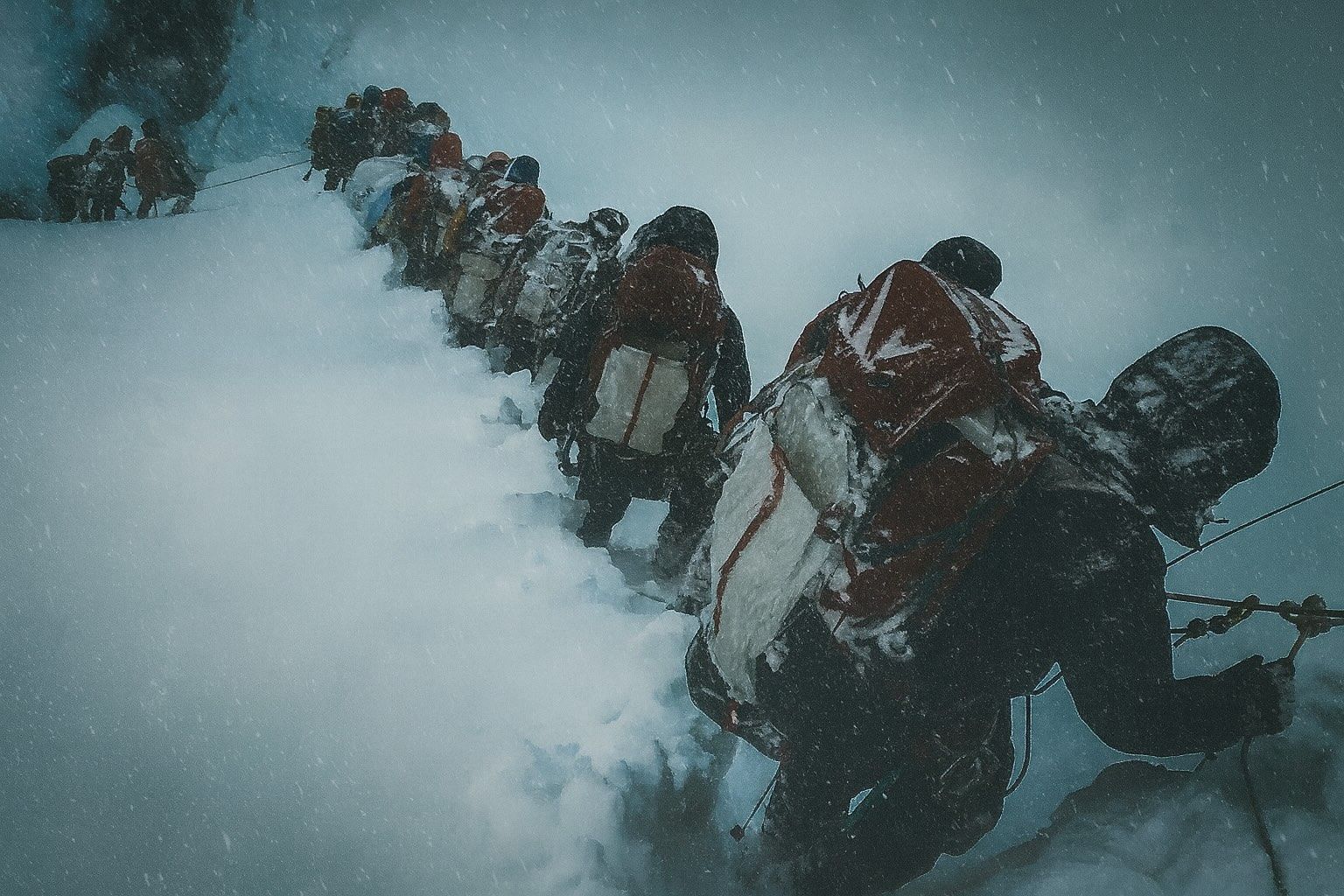- Unseasonal blizzard strands hikers – In early October 2025 a rare convective snowstorm battered the Tibetan slopes of Mount Everest during China’s Golden Week holiday, trapping hundreds of trekkers at altitudes above 4,000 m. Authorities said more than 350 hikers were led to safety, while rescuers remained in contact with at least 200 others who were still stranded [1] [2].
- Extreme conditions and hypothermia fears – Trekkers described the storm as the most extreme weather they had ever experienced. Snow fell continuously, tents were buried and hikers had to clear snow every ten minutes to avoid suffocation; some developed hypothermia and their windbreakers were soaked [3]. According to an eyewitness, the snow was so deep that people “cleared snow every 90 minutes to avoid being buried alive” [4].
- Massive rescue effort – Hundreds of locals, guides and rescue workers mobilised with horses and yaks to break trails and evacuate people. By mid‑week, about 350 people had reached a meeting point in Qudang, but an estimated 200 remained further up the valley [5]. Chinese authorities suspended ticket sales to the Everest Scenic Area and promised to aid all stranded hikers [6].
- Heavy rains wreak havoc in Nepal and India – The same system that produced the Everest blizzard dumped torrential rain across Nepal and neighbouring India. Flash floods and landslides swept away villages and infrastructure, killing at least 47 people in Nepal and more than 20 in India [7] [8]. Roads and bridges were destroyed, hampering relief efforts.
- Meteorological and climate drivers – Experts say a low‑pressure system over the Bay of Bengal prolonged the monsoon, bringing cold, moisture‑laden air to the Himalayas [9]. Studies also show that winters in the region have become drier and warmer, pushing the average snowline to around 6,100 m by January 2025 — about 150 m higher than in December 2024 [10]. Glaciologists warn that repeated high snowlines in 2021–2025 could indicate a “new normal” of volatile weather [11].
- Growing tourism and overcrowding pressures – Everest draws thousands of trekkers and climbers each year. In 2024 Tibet received more than 540,000 visitors, and 468 people obtained climbing permits from Nepal in 2025, generating US$5 million in revenue [12] [13]. The influx has led to overcrowding, pollution and safety concerns, prompting Nepal to consider a bill that would require climbers to summit a 7,000 m peak first, pay higher permit fees and deposit a non‑refundable garbage collection levy [14].
- Experts call for better management and climate resilience – Mountaineer Rebecca Stephens told the BBC that the combination of cold and wet snow on the Tibetan side created a high risk of hypothermia and avalanches [15]. Scientists emphasize that the Himalayas’ summer‑accumulation glaciers are vulnerable because 75 % of annual precipitation falls during the monsoon; warmer, drier winters increase sublimation and reduce snow accumulation [16].
A Rare Storm Triggers a Mount Everest Crisis
The sudden blizzard
The first week of October is normally considered a safe window to visit Tibet’s Karma Valley on the northern slopes of Mount Everest. The monsoon rains typically retreat, leaving crisp skies and manageable snow cover. But in 2025 the weather defied expectations. A low‑pressure system lingering over the Bay of Bengal channelled moist air into the Himalayas [17]. When the warm, humid air hit cold Himalayan air masses at around 4,000 m, a convective snowstorm formed over the Everest region. Snow began falling on Friday and intensified over the weekend, blanketing the landscape in drifts more than a metre deep [18].
Hundreds of trekkers – many Chinese tourists enjoying the Golden Week holiday – were hiking the route to Tibet’s Everest base camp when the storm struck. By Saturday night visibility had collapsed. Tents and trails vanished under snow; communications with guides were severed. According to state media, about 350 people managed to descend to a safer altitude and gather near Qudang, a village at 4,200 m [19]. Another 200 hikers were still stranded higher up, but rescuers maintained contact through satellite phones and WeChat groups [20].
Trekker testimonies
First‑hand accounts convey the severity of conditions. One hiker told the Guardian that violent winds and wet snow battered their campsite, forcing them to clear accumulations every 90 minutes to avoid being buried [21]. Others said they cleared snow “every ten minutes” and feared that if they slept, their tents would collapse [22]. Three people in one group developed hypothermia and were carried down by companions [23]. Another trekkers’ windbreakers were soaked, making it hard to retain body heat [24]. With electricity cut and water supplies frozen, hikers huddled inside lodges or tents, burning yak dung to stay warm. Dong Shuchang, who found refuge in a hotel, described seeing villagers and rescue teams heading up through waist‑deep snow while hikers nervously waited for help [25].
The risk of hypothermia was real. On the Tibetan plateau, daytime temperatures hover just above freezing, but wind chill during the storm drove perceived temperatures below –10 °C. Rebecca Stephens, the first British woman to summit Everest, explained that the combination of cold and wet snow made it easy for hikers to become hypothermic; soaked clothing loses its insulating value and the body burns energy quickly to stay warm [26]. For trekkers unfamiliar with high‑altitude storms, the conditions were terrifying and life‑threatening.
A community‑driven rescue
The rescue effort mobilised more than 700 people, including Tibetan villagers, guides, police, and specialized mountaineers. Without helicopters – which struggle to fly at high altitude in poor weather – teams used yaks and horses to ferry supplies and break trails. Eric Wen, a Chinese trekker, recounted how locals tied ropes to poles and guided hikers down steep, snow‑covered slopes while others dug a path through waist‑deep drifts [27]. State‑run tourism authorities suspended ticket sales to the Everest Scenic Area to prevent more visitors from arriving [28].
By Tuesday 350 evacuees had reached safety, but at least 200 trekkers were still stranded higher up in Karma Valley [29]. Rescue teams maintained contact with them and coordinated descent in stages. As conditions improved later in the week, most of the remaining hikers were successfully led down. Reports suggested that some unlicensed guides and local porters were unaccounted for, underscoring the challenges of verifying information in a remote region tightly controlled by the Chinese government [30].
Cascade of disasters across the Himalayas
While rescuers struggled on Everest’s northern slopes, heavy rains associated with the same weather system pummeled Nepal and India. In Nepal’s eastern districts, landslides and flash floods triggered by torrential rainfall destroyed houses and infrastructure, killing at least 47 people [31]. Villages were swept away by surging rivers, and two iron bridges collapsed in the district of Taplejung [32]. The storms inundated fields and roads, prompting the government to issue severe rainfall warnings. Across the border in India’s West Bengal and Sikkim, heavy rains and glacial lake outburst floods killed more than 20 people and displaced thousands [33].
Meteorologists say the unusual October deluge resulted from an interaction between the extended monsoon and a low‑pressure system in the Bay of Bengal [34]. This system funneled warm, moisture‑laden air northwards, where it collided with colder air in the Himalayas and produced heavy snowfall on the Tibetan plateau. The event shows how climate anomalies can produce simultaneous disasters: blizzards at higher elevations and deadly floods downstream.
The Bigger Picture: Climate Change and a New Himalayan Normal
Rising snowlines and volatile seasons
Scientists have observed a worrying trend: the average snowline in the Everest region has been creeping upward. Satellite images from the NASA Earth Observatory reveal that by January 2025 the snowline sat around 6,100 m – roughly 150 m higher than in December 2024 [35]. Glaciologist Mauri Pelto suggests that repeated high snowlines observed in 2021, 2023, 2024 and 2025 may indicate a “new normal” driven by warmer, drier winters [36]. The Himalayas depend on summer monsoon snows for mass balance; about 75 % of annual precipitation falls between June and September [37]. When winters are dry, strong winds and low humidity cause snow and ice to sublimate directly into water vapour, accelerating glacier retreat.
The rising snowline has cascading consequences. High‑altitude glaciers act as ‘water towers’ for South Asia, storing monsoon precipitation and releasing it gradually through meltwater. If glaciers shrink, downstream rivers experience more erratic flow: flash floods in wet months and drought in dry seasons. Higher snowlines also mean that mountain slopes remain exposed for longer, increasing rockfall and avalanche risk for climbers.
A monsoon that will not end
The October 2025 blizzard may also signal changes in the timing of the monsoon. Nepal normally receives 80 % of its annual rainfall from June to September [38]. Yet the low‑pressure system over the Bay of Bengal prolonged rainfall into October, catching trekkers and farmers off guard. Such events fit a pattern of increasingly erratic monsoons across South Asia, with periods of intense rainfall interspersed with drought. Climate models suggest that global warming intensifies the hydrological cycle, making storms wetter and dry spells hotter. The result is a higher risk of glacial lake outburst floods, landslides and storms like the Everest blizzard.
Human footprint and overcrowding
Mount Everest has become a global bucket‑list destination. The paved road on the Chinese side allows thousands of tourists to visit base camps without months of preparation. In 2024 Tibet’s Everest Scenic Area recorded more than 540,000 visitors [39]. On the Nepali side, 468 people obtained climbing permits in 2025, generating US$5 million for the government [40]. But this success comes at a cost. Lines of climbers queue along fixed ropes in the ‘death zone’, oxygen canisters litter the slopes, and human waste contaminates base camps. Overcrowding has contributed to traffic jams on summit day and even fatalities.
The crisis following the October blizzard revived calls for stricter regulation. Nepal’s proposed Integrated Tourism Bill would require climbers to summit at least a 7,000‑m Himalayan peak before attempting Everest, mandate hiring a Nepali guide, and impose a non‑refundable garbage‑collection fee [41]. The bill also proposes raising the US$11,000 permit fee and capping the number of climbers each season [42]. Officials argue that the world’s highest mountain must be protected from “pollution, waste and crowding” [43]. For many Sherpas and local entrepreneurs, however, tourism remains the backbone of the economy. Balancing livelihoods with safety and environmental stewardship will be crucial as climate change amplifies risks.
Political and information challenges
The rescue in Karma Valley also highlighted the opaque nature of Tibet under Chinese rule. Foreign journalists cannot freely travel to the region and must rely on official statements. State media initially claimed that all trekkers were accounted for, yet hikers’ posts on social media told a more desperate story. Although local authorities mobilised quickly, some questioned whether safety measures and early warnings were adequate. Open information about accidents and fatalities is critical for improving preparedness and accountability.
Lessons and Implications
The October 2025 Everest blizzard underscores how complex the intersection of climate change, tourism and politics can be. On one hand, the event was a humanitarian story of endurance and community spirit: villagers, guides and trekkers worked together to survive and descend. On the other, it was a stark demonstration of how quickly the Himalayan environment can shift from postcard‑perfect to perilous.
As global temperatures rise, extreme events in the Himalayas are likely to become more frequent and unpredictable. Rising snowlines, shifting monsoon patterns and glacial retreat will alter trekking seasons, avalanche risk and water availability. For the millions who depend on Himalayan rivers, this represents a looming crisis. The tourism industry must adapt by providing better safety training, stricter route management and emergency planning. Governments need to invest in early‑warning systems, maintain infrastructure and regulate visitor numbers to protect both people and the fragile environment.
Finally, the Everest blizzard should remind armchair adventurers and policy‑makers alike that the world’s highest peaks are not merely playgrounds but living systems sensitive to human and climatic pressures. As one trekker said while waiting to be rescued, “We thought we were visiting a wonder of nature. We did not expect nature to remind us that we are just visitors” [44].
The report provides an in-depth analysis of the rare snowstorm that stranded hundreds of trekkers on the Tibetan side of Mount Everest in October 2025. It details the extreme conditions faced by hikers, the large-scale rescue operations undertaken by locals and authorities, and the concurrent flash floods and landslides that devastated parts of Nepal and India. These events are contextualized within broader meteorological and climate trends, such as shifting monsoon patterns and rising snowlines caused by global warming [45] [46].
Beyond the immediate crisis, the report examines the implications for Everest tourism, highlighting overcrowding pressures and proposed regulatory reforms aimed at protecting both climbers and the environment [47]. It also underscores the political and informational challenges inherent in Tibetan rescue operations, as well as the need for better early-warning systems and sustainable tourism practices. Ultimately, the article argues that the Everest blizzard serves as a potent reminder of the fragile interplay between human ambition and the rapidly changing Himalayan ecosystem.
References
1. www.theguardian.com, 2. www.bbc.com, 3. www.bbc.com, 4. www.theguardian.com, 5. www.reuters.com, 6. www.theguardian.com, 7. www.bbc.com, 8. www.hindustantimes.com, 9. www.foxweather.com, 10. earthobservatory.nasa.gov, 11. earthobservatory.nasa.gov, 12. www.bbc.com, 13. www.csmonitor.com, 14. www.csmonitor.com, 15. www.bbc.com, 16. earthobservatory.nasa.gov, 17. www.foxweather.com, 18. www.reuters.com, 19. www.reuters.com, 20. www.theguardian.com, 21. www.theguardian.com, 22. www.bbc.com, 23. www.bbc.com, 24. www.bbc.com, 25. www.bbc.com, 26. www.bbc.com, 27. www.reuters.com, 28. www.theguardian.com, 29. www.bbc.com, 30. www.bbc.com, 31. www.bbc.com, 32. www.hindustantimes.com, 33. www.hindustantimes.com, 34. www.foxweather.com, 35. earthobservatory.nasa.gov, 36. earthobservatory.nasa.gov, 37. earthobservatory.nasa.gov, 38. www.foxweather.com, 39. www.bbc.com, 40. www.csmonitor.com, 41. www.csmonitor.com, 42. www.csmonitor.com, 43. www.csmonitor.com, 44. www.reuters.com, 45. www.foxweather.com, 46. earthobservatory.nasa.gov, 47. www.csmonitor.com










